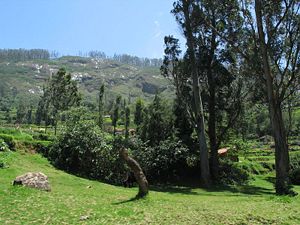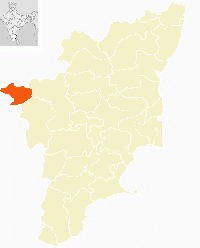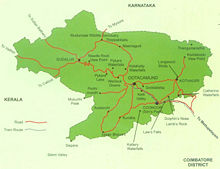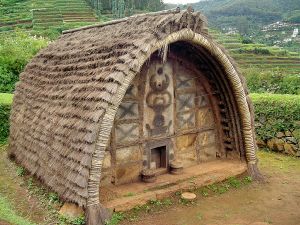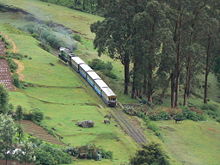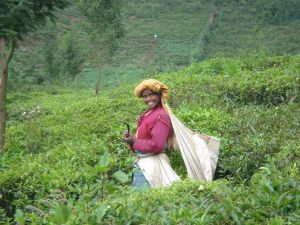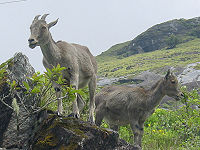Difference between revisions of "Nilgiris district" - New World Encyclopedia
Dan Davies (talk | contribs) |
Rosie Tanabe (talk | contribs) |
||
| (32 intermediate revisions by 4 users not shown) | |||
| Line 1: | Line 1: | ||
| − | {{images OK}} | + | {{approved}}{{submitted}}{{ready}}{{images OK}}{{copyedited}} |
| − | [[Image: | + | [[Image:Nilgiri-Hills.jpg|thumb|right|300px|The Nilgiri Hills]] |
| + | |||
| + | The '''Nilgiris District''' is in the [[India]]n [[states and territories of India|state]] of [[Tamil Nadu]]. '''Nilgiri''' (Tamil : நீலகிரி or '''Blue Mountains''' when translated into English) is also the name given to a range of mountains spread across the states of [[Tamilnadu]] as well as [[Karnataka]] and [[Kerala]]. The [[Nilgiri Hills]] comprise part of a larger mountain chain known as the [[Western Ghats]]. The mountain [[Doddabetta]] has the highest elevation, standing at a height of {{convert|2637|m|ft}}. The district resides mainly contained within that mountain range. | ||
| − | The | + | The Nilgiris district has been the homeland of native [[tribal people]]s including the [[Todas]], [[Kotas]], and [[Badagas]]. The [[Toda people]] have been the subject of much study by [[Cultural Anthropology|cultural anthropologists]], bringing them an international renown dis-proportionate with their numbers. The study of the Toda people established the model for study of [[indigenous peoples]] throughout the world. [[Europeans]] have explored the Nilgiris District extensively, leading to the region becoming a popular [[summer]] retreat for the [[British East India Company]] during the nineteenth century and the [[British Raj|British colonial government]] during the twentieth century. Located on the southern tip of [[Southern India|India]] in [[Tamil Nadu]], and easily accessible to shipping, [[Portuguese]] colonies monopolized the region from the sixteenth century until the British gained control during the eighteenth century. |
| + | {{toc}} | ||
| + | The British constructed the [[Nilgiri Mountain Railway]], a part of the [[Mountain Railways of India]] which [[UNESCO]] designated a World Heritage Site. Two eco-regions cover the district, the [[South Western Ghats moist deciduous forests]] and [[South Western Ghats montane rain forests]], providing refuge for native animals such as the [[Nilgiri Tahr]]. Three [[National parks of India|national parks]] within the district further protect the natural habitat of Nilgiris District, [[Mudumalai National Park]], [[Mukurthi National Park]], and [[Silent Valley National Park]]. | ||
==History== | ==History== | ||
| − | [[Image: | + | [[Image:TN Districts Nilgiri.gif|thumb|200px|Nilgiris district in Tamil Nadu, India]] |
| − | Human history in the Nilgiri hills dates back many centuries. The | + | Human history in the Nilgiri hills dates back many centuries. The name may come from the smoky-like haze that envelopes the area, or the ''[[kurunji]]'' flower which blooms every twelve years giving the slopes a bluish tinge. |
| − | Originally tribal land, the [[Todas]] occupied the the Ooty area and the [[Kotas]] the Kotagiri area. The [[Badagas]] appeared much later, migrating from the [[Mysore Plateau]], in 1550 C.E.. The [[Ramayana]] of [[Valmiki]] (estimated by Western scholars to have been recorded in the second century B.C.E.) mentions the Nilgiri hills. Europeans first set foot the jungles in 1602 when a Portuguese priest, Ferreiri, successfully explored the hills. He discovered the [[Toda people]]. Ferreiri remained the only European to explore this area for more than two hundred years. | + | Originally tribal land, the [[Todas]] occupied the the Ooty area and the [[Kotas]] the Kotagiri area. The [[Badagas]] appeared much later, migrating from the [[Mysore Plateau]], in 1550 C.E.. The [[Ramayana]] of [[Valmiki]] (estimated by Western scholars to have been recorded in the second century B.C.E.) mentions the Nilgiri hills. Europeans first set foot the jungles in 1602 when a Portuguese priest, Ferreiri, successfully explored the hills. He discovered the [[Toda people]]. Ferreiri remained the only European to explore this area for more than two hundred years.<ref>Kavita Philip, ''Civilizing Natures: Race, Resources, and Modernity in Colonial South India'' (New Delhi: Orient Longman, 2003), 43.</ref> |
Around 1810, the the British East India Company unsuccessfully attempted to survey the Nilgiris Hills jungles. Englishman [[Francis Buchanan-Hamilton|Francis Buchanan]] led the failed surveying expedition. Next John Sullivan, the Collector of Coimbatore just south of the Nilgiris, sent two surveyors, Keys and Macmohan, to make a comprehensive study of the hills. They went as far as the lower level of Ooty but failed to explore the entire valley. Keys' and Macmohan's (their first names had not been recored) mission held significance as they had been the first Englishmen to set foot in the Nilgiri hills, leading to the opening of the area to British colonialism. | Around 1810, the the British East India Company unsuccessfully attempted to survey the Nilgiris Hills jungles. Englishman [[Francis Buchanan-Hamilton|Francis Buchanan]] led the failed surveying expedition. Next John Sullivan, the Collector of Coimbatore just south of the Nilgiris, sent two surveyors, Keys and Macmohan, to make a comprehensive study of the hills. They went as far as the lower level of Ooty but failed to explore the entire valley. Keys' and Macmohan's (their first names had not been recored) mission held significance as they had been the first Englishmen to set foot in the Nilgiri hills, leading to the opening of the area to British colonialism. | ||
| − | Although Keys and Macmohan made the first extensive trip in the region, | + | Although Keys and Macmohan made the first extensive trip in the region, J.C. Whish and N.W. Kindersley have been credited with the first thorough exploration of the region. They worked for the Madras Civil Service, making a journey in 1819 into the Nilgiris Hills. They reported to their superiors that they had discovered "the existence of a tableland possessing a European climate." <ref>Madras, ''Manual of the Administration of the Madras Presidency: In Illustration of the Records of Government & the Yearly Administration Reports'' (Madras: Printed by E. Keys at the Government Press, 1885), 108.</ref> |
John Sullivan, the Collector of Coimbatore, who went up the same year and built a home, had been the first European resident of the hills. He reported to the Madras Government the suitability of the climate; Europeans soon thereafter settled in the valley for year round and for summer stays. The valley became a summer resort with the British government using the hills for a summer capital. By the end of the nineteenth century, the Nilgiri hills became easily accessible with the building of roads and the construction of a railroad. | John Sullivan, the Collector of Coimbatore, who went up the same year and built a home, had been the first European resident of the hills. He reported to the Madras Government the suitability of the climate; Europeans soon thereafter settled in the valley for year round and for summer stays. The valley became a summer resort with the British government using the hills for a summer capital. By the end of the nineteenth century, the Nilgiri hills became easily accessible with the building of roads and the construction of a railroad. | ||
==Geography and climate== | ==Geography and climate== | ||
| − | [[Image:Nilgiris.jpg|thumb|Map of the Nilgiris district]] | + | [[Image:Nilgiris.jpg|thumb|right|220px|Map of the Nilgiris district]] |
| − | The district has an area of 2,452.50 sq.km.<ref name=autogenerated1>[http://www.nilgiris.tn.gov.in/ Welcome to Nilgiris] | + | The district has an area of 2,452.50 sq.km.<ref name=autogenerated1>Nilgiris, [http://www.nilgiris.tn.gov.in/ Welcome to Nilgiris.] Retrieved September 3, 2008.</ref> The district, basically a hilly region, sits at an elevation of 900 to 2,636 meters above mean sea level (MSL). Nearly the entire district lies in the [[Western ghats]]. Its latitudinal and longitudinal dimensions being 130 kilometers (Latitude: 10-38 WP 11-49N) by 185 kilometers (Longitude: 76.0 E to 77.15 E). The Nilgiris is bounded to the north by [[Karnataka]], to the east by [[Coimbatore district]], [[Erode district]], the south by Coimbatore district and [[Kerala]] and to the west by Kerala. Nilgiris district has a rolling and steep topography with approximately sixty percent of the cultivable land in slopes ranging from sixteen percent to thirty five percent inclines.<ref>M. S. V. Rama Rao, ''Soil Conservation in India'' (New Delhi: Indian Council of Agricultural Research 1962), 269.</ref> |
| − | |||
| − | |||
| − | |||
| − | |||
| − | The | + | The high altitude of the Nilgiris produces a cooler and wetter climate than the surrounding plains, making the region a popular retreat from the summer heat. During the summer months, the temperature reaches a maximum of 21°C to 25°C and a minimum of 10°C to 12°C. During winter months, temperatures reach a high of 16°C to 21°C and a low of 2°C.<ref name=autogenerated1 /> The rolling hills of the Downs look similar to [[the Downs]] in Southern [[England]], and were used for similar activities such as hunting. |
| − | = | + | The district usually receives rain both during the Southwest Monsoon and Northeast Monsoon. The entire Gudalur and Pandalaur, Kundah Taluks and portion of Udhagamandalam Taluk receive rain from the Southwest Monsoon and some portion of Udhagamandalam Taluk and the entire Coonoor and Kotagiri Taluks benefit from the rains of Northeast Monsoon. Sixteen rainfall registering stations dot the district. The average annual rainfall of the district measures 1,920.80 millimeters.<ref name=autogenerated1 /> |
| − | + | [[Ootacamund]], or Udhagamandalam, the district capital, constitutes the principal town of the area. The town also has several buildings in British-style architecture, especially the church buildings. A road junction has the name Charing Cross. The other main towns in the Nilgiris include [[Coonoor]], [[Kotagiri]], [[Gudalur (Nilgiris district)|Gudalur]] and [[Aruvankadu]]. Well-known tourist spots in Coonoor include Lambsrock and Sims park. In Sims park, the city hosts a "Fruit Show" in the summer. Vendors display all the varieties of fruit during the show. | |
==Demographics== | ==Demographics== | ||
[[Image:Toda Hut.JPG|thumb|right|Hut of Toda tribe in the Nilgiris]] | [[Image:Toda Hut.JPG|thumb|right|Hut of Toda tribe in the Nilgiris]] | ||
| − | + | Several tribes live in the Nilgiris whose origins remain obscure. The [[Toda (tribe)|Toda]] people are the best known of those. They base their culture on [[cattle]], and their red, black and white embroidered [[shawl]]s, and silver [[jewelry]] have been much in demand. The district also serves as home to the Paniya tribes and the [[Badagas|Badaga people]]. | |
| − | The district | ||
| − | + | [[Tamil language|Tamil]] is the principal language spoken in the Nilgiris. Many people speak and understand [[English language|English]]. [[Malayalam]], [[Kannada]] & [[Hindi]] have more limited usage among the population. The Nilgiris is also home to the [[Toda language]], spoken by the [[Toda people]]. The [[Badagas|Badaga people]], who number around 250,000, speak the [[Badaga language]]. The language of [[Paniya]] is spoken in the western parts of the district where the Paniya tribes live. As per the 2001 Census, Hindus formed the majority of the population (78.60 percent), followed by Christians (11.45 percent), Muslims (9.55 percent) and others (0.4 percent).<ref>Census, [http://www.census.tn.nic.in/religion.aspx Religion Census]. Retrieved September 3, 2008.</ref> | |
| − | |||
| − | [[Tamil language|Tamil]] is the principal language spoken in the Nilgiris. Many people speak and understand [[English language|English]]. [[Malayalam]], [[Kannada]] & [[Hindi]] | ||
The table listed below gives the basic census data for the district based on the census of 2001.<ref name=autogenerated1 /> | The table listed below gives the basic census data for the district based on the census of 2001.<ref name=autogenerated1 /> | ||
| Line 51: | Line 48: | ||
|} | |} | ||
| − | == | + | ==Nilgiri Mountain Railway== |
| − | + | [[Image:The Nilgiri Mountain Railway.jpg|thumb|thumb|right|220px|The Nilgiri Mountain Railway]] | |
| − | [[Image:The Nilgiri Mountain Railway.jpg|thumb|The Nilgiri Mountain Railway]] | + | The Nagapattinam - Gudalur National Highway Passes through the district. The [[Nilgiri Ghat Roads]] link the district with the nearest cities in Tamilnadu, Kerala and Karnataka. All the taluks connect with major district roads. The Panchayat Union maintains the village roads. |
| − | The Nagapattinam - Gudalur National Highway Passes through | ||
| − | |||
| − | |||
| − | |||
| − | |||
| − | |||
| − | |||
| − | |||
| − | |||
| − | |||
| − | |||
| − | |||
| − | |||
| − | == | + | [[UNESCO]] designated the [[Mountain Railways of India|Nilgiri Mountain Railway]] a [[World Heritage Site]].<ref>UNESCO, [http://whc.unesco.org/en/list/944/multiple=1&unique_number=1102 Official UNESCO list of World Heritage Sites—Mountain Railways of India.] Retrieved September 3, 2008.</ref> The [[Nilgiri Mountain Railway]] runs from [[Mettupalayam]] to Udhagamandalam via Coonoor, carrying a regular passenger load of locals and tourists. The train services many of the populated areas of the district including Coonoor, [[Wellington]], Aruvankadu, [[Ketti]], [[Lovedale]], and [[Ooty]]. |
| − | |||
==Agriculture== | ==Agriculture== | ||
[[Image:Tea picker in Nilgiris.jpg|thumb|A tea picker in the Nilgiris]] | [[Image:Tea picker in Nilgiris.jpg|thumb|A tea picker in the Nilgiris]] | ||
| − | The Nilgiris District | + | The economy of the Nilgiris District, an agricultural district<ref name=autogenerated1 />, depends upon the success of crops like [[potato]], [[cabbage]], [[carrot]], [[tea]], [[coffee]], [[spice]]s, and [[fruits]]. Plantation crops such as tea and coffee make up the largest share of the agricultural economy. [[Nilgiri tea|Tea]] grows at elevations of 1,000 to above 2,500 meters. The area also produces [[eucalyptus]] oil and temperate zone vegetables. Potato and other vegetables grow in Udhagai and Coonoor Taluks, while paddy and ginger are grown in Gudalur and Pandalur Taluks. |
| + | |||
| + | [[Rice|Paddy]] is also grown in Thengumarahada area in Kotagiri Taluk. Besides those crops, ragi, samai, wheat, and vegetables grow to a lesser extent throughout the district. With irrigation lacking in the district, the crops depend mainly upon rain for water. Check Dams have been constructed with natural springs when possible. | ||
==Ecoregions== | ==Ecoregions== | ||
| − | + | Two [[ecoregion]]s cover portions of the Nilgiris. The [[South Western Ghats moist deciduous forests]] lie between 250 and 1000 meters elevation. Those forests extend south along the Western Ghats range to the southern tip of India. A diverse variety of trees populate the forests, many of [[deciduous]]. The forests serve as home to the largest herd of [[Asian Elephant]]s in India, which range from the Nilgiris to the [[Eastern Ghats]]. The Nilgiris and the South Western Ghats also serves as one of the most important [[tiger]] habitats in India. | |
| − | |||
| − | Two [[ecoregion]]s cover portions of the Nilgiris. The [[South Western Ghats moist deciduous forests]] lie between 250 and 1000 meters elevation. | ||
| − | The [[South Western Ghats montane rain forests]] ecoregion covers the portion of the range above 1000 meters elevation. | + | The [[South Western Ghats montane rain forests]] ecoregion covers the portion of the range above 1000 meters elevation. Those evergreen rain forests number among the most diverse on the planet. Above 1500 meters elevation, the evergreen forests begin to give way to stunted forests called ''[[shola]]s,'' interspersed with open grassland. Those grasslands serve as the home to the endangered [[Nilgiri Tahr]], which resembles a stocky goat with curved horns. The Nilgiri Tahrs live only in the [[montane grassland]]s of the South Western Ghats, and number only about 2000. |
| − | [[Image:Niltahr.jpg|thumb|right|Nilgiri Tahr in The Nilgiris]] | + | [[Image:Niltahr.jpg|thumb|right|200px|Nilgiri Tahr in The Nilgiris]] |
| − | |||
| − | The region has given its name to a number of bird species, including the [[Nilgiri Pipit]], [[Nilgiri Woodpigeon]] and [[Nilgiri Blackbird]]. | + | Three [[National parks of India|national parks]] protect portions of the Nilgiris. [[Mudumalai National Park]] lies in the northern part of the range where Kerala, [[Karnataka]], and Tamil Nadu meet, and covers an area of 321 km². [[Mukurthi National Park]] lies in the southwest part of the range, in Kerala, and covers an area of 78.5 km², which includes intact ''shola''-grassland mosaic, habitat for the Nilgiri tahr. [[Silent Valley National Park]] lies just to the south and contiguous with those two parks, covering an area of 89.52 km². Outside the boundaries of those parks, locals have cleared large tracts of the native forest to graze cattle, and for plantations of [[tea]], [[Eucalyptus]], [[ganga]] and [[Acacia]]. The entire range, together with portions of the Western Ghats to the northwest and southwest, had been included in the [[Nilgiri Biosphere Reserve]] in 1986, India's first biosphere reserve. The region has given its name to a number of bird species, including the [[Nilgiri Pipit]], [[Nilgiri Woodpigeon]], and [[Nilgiri Blackbird]]. |
| + | [[Image:Sigurghat.JPG|thumb|center|820px|Sigur Ghat]] | ||
==Gallery== | ==Gallery== | ||
| Line 91: | Line 74: | ||
Image:Lovedale railway station.JPG|Lovedale railway station | Image:Lovedale railway station.JPG|Lovedale railway station | ||
Image:Nilgiri ooty railway station .JPG|Udhagamandalam railway station | Image:Nilgiri ooty railway station .JPG|Udhagamandalam railway station | ||
| + | Image:Nilgiri mountain view.jpg|A view of the Nilgiri hills | ||
Image:Ootybotanicalgarden125631012pan.jpg|Botanical Gardens at [[Udhagamandalam]] | Image:Ootybotanicalgarden125631012pan.jpg|Botanical Gardens at [[Udhagamandalam]] | ||
Image:Ootyviewpanaromaracecourse003pan.jpg|A panaromic view of Udhagamandalam | Image:Ootyviewpanaromaracecourse003pan.jpg|A panaromic view of Udhagamandalam | ||
| + | Image:EucalyptusNilgiris.jpg|A 1917 photo of ''Eucalptus globulosum'' plantation | ||
| + | |||
</gallery> | </gallery> | ||
</center> | </center> | ||
==See also== | ==See also== | ||
| − | *[[ | + | * [[Kerala]] |
| + | * [[Toda people]] | ||
| + | * [[Mountain Railways of India]] | ||
| + | * [[Climate of India]] | ||
==Notes== | ==Notes== | ||
<references/> | <references/> | ||
| − | |||
| − | |||
==References== | ==References== | ||
| − | * Madras | + | * Francis, W. 1984. ''The Nilgiris.''' Delhi: B.R. Pub. Corp. OCLC 12722884. |
| + | * Madras. 1885. ''Manual of the Administration of the Madras Presidency: In Illustration of the Records of Government & the Yearly Administration Reports.'' Madras: Printed by E. Keys at the Government Press. OCLC 221456000. | ||
| + | * Philip, Kavita. 2003. ''Civilizing Natures: Race, Resources, and Modernity in Colonial South India. New Perspectives in South Asian History, 6.'' New Delhi: Orient Longman. ISBN 9788125025863. | ||
| + | * Rama Rao, M. S. V. 1962. ''Soil Conservation in India.'' New Delhi: Indian Council of Agricultural Research. OCLC 5865800. | ||
| + | * Ranga, N. G. 1934. ''The Tribes of the Nilgiris Their Social and Economic Conditions.'' Andhra economic series, 5. Bezwada: G.L. Narayan. OCLC 23877536. | ||
| − | |||
| − | |||
| − | |||
| − | |||
| − | |||
| − | |||
| − | |||
| − | |||
| − | |||
| − | |||
| − | |||
| − | |||
[[Category:Geography]] | [[Category:Geography]] | ||
| − | |||
{{credits|232811609}} | {{credits|232811609}} | ||
Latest revision as of 04:44, 15 November 2022
The Nilgiris District is in the Indian state of Tamil Nadu. Nilgiri (Tamil : நீலகிரி or Blue Mountains when translated into English) is also the name given to a range of mountains spread across the states of Tamilnadu as well as Karnataka and Kerala. The Nilgiri Hills comprise part of a larger mountain chain known as the Western Ghats. The mountain Doddabetta has the highest elevation, standing at a height of 2,637 meters (8,650 ft). The district resides mainly contained within that mountain range.
The Nilgiris district has been the homeland of native tribal peoples including the Todas, Kotas, and Badagas. The Toda people have been the subject of much study by cultural anthropologists, bringing them an international renown dis-proportionate with their numbers. The study of the Toda people established the model for study of indigenous peoples throughout the world. Europeans have explored the Nilgiris District extensively, leading to the region becoming a popular summer retreat for the British East India Company during the nineteenth century and the British colonial government during the twentieth century. Located on the southern tip of India in Tamil Nadu, and easily accessible to shipping, Portuguese colonies monopolized the region from the sixteenth century until the British gained control during the eighteenth century.
The British constructed the Nilgiri Mountain Railway, a part of the Mountain Railways of India which UNESCO designated a World Heritage Site. Two eco-regions cover the district, the South Western Ghats moist deciduous forests and South Western Ghats montane rain forests, providing refuge for native animals such as the Nilgiri Tahr. Three national parks within the district further protect the natural habitat of Nilgiris District, Mudumalai National Park, Mukurthi National Park, and Silent Valley National Park.
History
Human history in the Nilgiri hills dates back many centuries. The name may come from the smoky-like haze that envelopes the area, or the kurunji flower which blooms every twelve years giving the slopes a bluish tinge.
Originally tribal land, the Todas occupied the the Ooty area and the Kotas the Kotagiri area. The Badagas appeared much later, migrating from the Mysore Plateau, in 1550 C.E.. The Ramayana of Valmiki (estimated by Western scholars to have been recorded in the second century B.C.E.) mentions the Nilgiri hills. Europeans first set foot the jungles in 1602 when a Portuguese priest, Ferreiri, successfully explored the hills. He discovered the Toda people. Ferreiri remained the only European to explore this area for more than two hundred years.[1]
Around 1810, the the British East India Company unsuccessfully attempted to survey the Nilgiris Hills jungles. Englishman Francis Buchanan led the failed surveying expedition. Next John Sullivan, the Collector of Coimbatore just south of the Nilgiris, sent two surveyors, Keys and Macmohan, to make a comprehensive study of the hills. They went as far as the lower level of Ooty but failed to explore the entire valley. Keys' and Macmohan's (their first names had not been recored) mission held significance as they had been the first Englishmen to set foot in the Nilgiri hills, leading to the opening of the area to British colonialism.
Although Keys and Macmohan made the first extensive trip in the region, J.C. Whish and N.W. Kindersley have been credited with the first thorough exploration of the region. They worked for the Madras Civil Service, making a journey in 1819 into the Nilgiris Hills. They reported to their superiors that they had discovered "the existence of a tableland possessing a European climate." [2]
John Sullivan, the Collector of Coimbatore, who went up the same year and built a home, had been the first European resident of the hills. He reported to the Madras Government the suitability of the climate; Europeans soon thereafter settled in the valley for year round and for summer stays. The valley became a summer resort with the British government using the hills for a summer capital. By the end of the nineteenth century, the Nilgiri hills became easily accessible with the building of roads and the construction of a railroad.
Geography and climate
The district has an area of 2,452.50 sq.km.[3] The district, basically a hilly region, sits at an elevation of 900 to 2,636 meters above mean sea level (MSL). Nearly the entire district lies in the Western ghats. Its latitudinal and longitudinal dimensions being 130 kilometers (Latitude: 10-38 WP 11-49N) by 185 kilometers (Longitude: 76.0 E to 77.15 E). The Nilgiris is bounded to the north by Karnataka, to the east by Coimbatore district, Erode district, the south by Coimbatore district and Kerala and to the west by Kerala. Nilgiris district has a rolling and steep topography with approximately sixty percent of the cultivable land in slopes ranging from sixteen percent to thirty five percent inclines.[4]
The high altitude of the Nilgiris produces a cooler and wetter climate than the surrounding plains, making the region a popular retreat from the summer heat. During the summer months, the temperature reaches a maximum of 21°C to 25°C and a minimum of 10°C to 12°C. During winter months, temperatures reach a high of 16°C to 21°C and a low of 2°C.[3] The rolling hills of the Downs look similar to the Downs in Southern England, and were used for similar activities such as hunting.
The district usually receives rain both during the Southwest Monsoon and Northeast Monsoon. The entire Gudalur and Pandalaur, Kundah Taluks and portion of Udhagamandalam Taluk receive rain from the Southwest Monsoon and some portion of Udhagamandalam Taluk and the entire Coonoor and Kotagiri Taluks benefit from the rains of Northeast Monsoon. Sixteen rainfall registering stations dot the district. The average annual rainfall of the district measures 1,920.80 millimeters.[3]
Ootacamund, or Udhagamandalam, the district capital, constitutes the principal town of the area. The town also has several buildings in British-style architecture, especially the church buildings. A road junction has the name Charing Cross. The other main towns in the Nilgiris include Coonoor, Kotagiri, Gudalur and Aruvankadu. Well-known tourist spots in Coonoor include Lambsrock and Sims park. In Sims park, the city hosts a "Fruit Show" in the summer. Vendors display all the varieties of fruit during the show.
Demographics
Several tribes live in the Nilgiris whose origins remain obscure. The Toda people are the best known of those. They base their culture on cattle, and their red, black and white embroidered shawls, and silver jewelry have been much in demand. The district also serves as home to the Paniya tribes and the Badaga people.
Tamil is the principal language spoken in the Nilgiris. Many people speak and understand English. Malayalam, Kannada & Hindi have more limited usage among the population. The Nilgiris is also home to the Toda language, spoken by the Toda people. The Badaga people, who number around 250,000, speak the Badaga language. The language of Paniya is spoken in the western parts of the district where the Paniya tribes live. As per the 2001 Census, Hindus formed the majority of the population (78.60 percent), followed by Christians (11.45 percent), Muslims (9.55 percent) and others (0.4 percent).[5]
The table listed below gives the basic census data for the district based on the census of 2001.[3]
| Total Population | Male Population | Female Population | Sex ratio | |
|---|---|---|---|---|
| Rural | 307,532 | 151,874 | 155,658 | 1,025 |
| Urban | 454,609 | 226,477 | 228,132 | 1,007 |
| Total | 762,141 | 378,351 | 383,790 | 1,014 |
Nilgiri Mountain Railway
The Nagapattinam - Gudalur National Highway Passes through the district. The Nilgiri Ghat Roads link the district with the nearest cities in Tamilnadu, Kerala and Karnataka. All the taluks connect with major district roads. The Panchayat Union maintains the village roads.
UNESCO designated the Nilgiri Mountain Railway a World Heritage Site.[6] The Nilgiri Mountain Railway runs from Mettupalayam to Udhagamandalam via Coonoor, carrying a regular passenger load of locals and tourists. The train services many of the populated areas of the district including Coonoor, Wellington, Aruvankadu, Ketti, Lovedale, and Ooty.
Agriculture
The economy of the Nilgiris District, an agricultural district[3], depends upon the success of crops like potato, cabbage, carrot, tea, coffee, spices, and fruits. Plantation crops such as tea and coffee make up the largest share of the agricultural economy. Tea grows at elevations of 1,000 to above 2,500 meters. The area also produces eucalyptus oil and temperate zone vegetables. Potato and other vegetables grow in Udhagai and Coonoor Taluks, while paddy and ginger are grown in Gudalur and Pandalur Taluks.
Paddy is also grown in Thengumarahada area in Kotagiri Taluk. Besides those crops, ragi, samai, wheat, and vegetables grow to a lesser extent throughout the district. With irrigation lacking in the district, the crops depend mainly upon rain for water. Check Dams have been constructed with natural springs when possible.
Ecoregions
Two ecoregions cover portions of the Nilgiris. The South Western Ghats moist deciduous forests lie between 250 and 1000 meters elevation. Those forests extend south along the Western Ghats range to the southern tip of India. A diverse variety of trees populate the forests, many of deciduous. The forests serve as home to the largest herd of Asian Elephants in India, which range from the Nilgiris to the Eastern Ghats. The Nilgiris and the South Western Ghats also serves as one of the most important tiger habitats in India.
The South Western Ghats montane rain forests ecoregion covers the portion of the range above 1000 meters elevation. Those evergreen rain forests number among the most diverse on the planet. Above 1500 meters elevation, the evergreen forests begin to give way to stunted forests called sholas, interspersed with open grassland. Those grasslands serve as the home to the endangered Nilgiri Tahr, which resembles a stocky goat with curved horns. The Nilgiri Tahrs live only in the montane grasslands of the South Western Ghats, and number only about 2000.
Three national parks protect portions of the Nilgiris. Mudumalai National Park lies in the northern part of the range where Kerala, Karnataka, and Tamil Nadu meet, and covers an area of 321 km². Mukurthi National Park lies in the southwest part of the range, in Kerala, and covers an area of 78.5 km², which includes intact shola-grassland mosaic, habitat for the Nilgiri tahr. Silent Valley National Park lies just to the south and contiguous with those two parks, covering an area of 89.52 km². Outside the boundaries of those parks, locals have cleared large tracts of the native forest to graze cattle, and for plantations of tea, Eucalyptus, ganga and Acacia. The entire range, together with portions of the Western Ghats to the northwest and southwest, had been included in the Nilgiri Biosphere Reserve in 1986, India's first biosphere reserve. The region has given its name to a number of bird species, including the Nilgiri Pipit, Nilgiri Woodpigeon, and Nilgiri Blackbird.
Gallery
See also
Notes
- ↑ Kavita Philip, Civilizing Natures: Race, Resources, and Modernity in Colonial South India (New Delhi: Orient Longman, 2003), 43.
- ↑ Madras, Manual of the Administration of the Madras Presidency: In Illustration of the Records of Government & the Yearly Administration Reports (Madras: Printed by E. Keys at the Government Press, 1885), 108.
- ↑ 3.0 3.1 3.2 3.3 3.4 Nilgiris, Welcome to Nilgiris. Retrieved September 3, 2008.
- ↑ M. S. V. Rama Rao, Soil Conservation in India (New Delhi: Indian Council of Agricultural Research 1962), 269.
- ↑ Census, Religion Census. Retrieved September 3, 2008.
- ↑ UNESCO, Official UNESCO list of World Heritage Sites—Mountain Railways of India. Retrieved September 3, 2008.
ReferencesISBN links support NWE through referral fees
- Francis, W. 1984. The Nilgiris.' Delhi: B.R. Pub. Corp. OCLC 12722884.
- Madras. 1885. Manual of the Administration of the Madras Presidency: In Illustration of the Records of Government & the Yearly Administration Reports. Madras: Printed by E. Keys at the Government Press. OCLC 221456000.
- Philip, Kavita. 2003. Civilizing Natures: Race, Resources, and Modernity in Colonial South India. New Perspectives in South Asian History, 6. New Delhi: Orient Longman. ISBN 9788125025863.
- Rama Rao, M. S. V. 1962. Soil Conservation in India. New Delhi: Indian Council of Agricultural Research. OCLC 5865800.
- Ranga, N. G. 1934. The Tribes of the Nilgiris Their Social and Economic Conditions. Andhra economic series, 5. Bezwada: G.L. Narayan. OCLC 23877536.
Credits
New World Encyclopedia writers and editors rewrote and completed the Wikipedia article in accordance with New World Encyclopedia standards. This article abides by terms of the Creative Commons CC-by-sa 3.0 License (CC-by-sa), which may be used and disseminated with proper attribution. Credit is due under the terms of this license that can reference both the New World Encyclopedia contributors and the selfless volunteer contributors of the Wikimedia Foundation. To cite this article click here for a list of acceptable citing formats.The history of earlier contributions by wikipedians is accessible to researchers here:
The history of this article since it was imported to New World Encyclopedia:
Note: Some restrictions may apply to use of individual images which are separately licensed.
